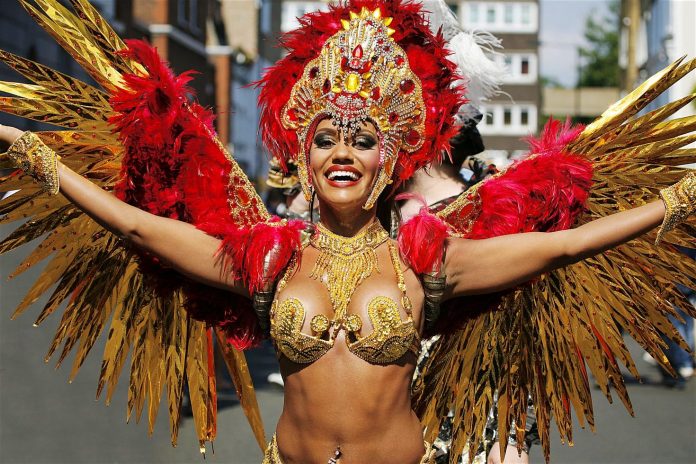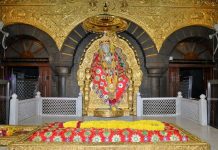Dancing in the streets, earth-shaking soundsystems and heady aromas of BBQ pits: Notting Hill Carnival returns to West London this August with its unmissable taste of all things Caribbean. With over one million people expected to attend and hundreds of things to see and do the event can be overwhelming, but don’t let that faze you. Read through this guide, dig out your best feather-trimmed two-piece, and join the celebration of West Indies heritage and culture.
When does Notting Hill Carnival take place?
Notting Hill Carnival takes place on Sunday 25 August and Monday 26 August 2019. They’re the official, free-to-attend dates, but there are countless pre- and post-Carnival parties to make the most of the long weekend.
On Saturday 24 August, it’s the steelband competition Panorama. The open-air play-off will crown the UK’s best steelband, and takes place in Emslie Horniman’s Pleasance Park from 6pm. Tickets are £10 with proceeds split evenly between all the bands.
Lots of people take children to the carnival, especially on Sunday. It’s generally a bit quieter, but there’s still parades, so families should be prepared for big crowds.
On Monday the festival is in full swing: jam-packed streets, dancing revellers, and soundsystems blasting out soca. It’s also the day of the main parade, when Mas Bands with their dancers kitted out in glittering costumes dance their way around the perimeter of the event. Full timings and a parade route will be announced closer to the day; check the official website for up-to-date information and/or download the app.
 A Carnival dancer lost in music © Ms Jane Campbell / Shutterstock
A Carnival dancer lost in music © Ms Jane Campbell / Shutterstock
Where are the best sound systems?
One of the biggest joys of Notting Hill Carnival is stumbling upon a sound system that’s playing your tunes. Some people hop from one to another before they settle on one for a boogie, while others plan a route to visit their favourite DJ collectives. Either way, there’s something for everyone, from reggae to hip hop, cumbia to house. Salsa fans should check out the Latin Rave on Portobello Road; reggae lovers head to festival veterans Channel One Sound System for classic roots; or get your funk fix at Disco Hustlers on Powis Square.
What’s the food and drink situation?
The Jamaican jerk chicken is a must-try at the festival, and with over 300 food traders serving this year’s festival you’ll easily find something to fuel your dancing. Veggie options are available too, and last year there was an increased focus on vegan food. If they’re drinking, most people bring their own alcohol, but you can keep hydrated with a fresh coconut or indulge in a rum cocktail from one of the street traders. ATMs are dotted around but they might run dry – save yourself a headache and get cash out in advance.

What’s the best way to get there?
There’s over a million people estimated to attend this year’s event, so it’s best to make peace with queuing for the tube now. Leaving adequate time to get around is vital, as the streets will be jam-packed with people. Ladbroke Grove tube station will be closed on the day to avoid overcrowding, and some stations – like Holland Park and Notting Hill Gate – might have restrictions. The Notting Hill Carnival app has a handy map with the best bus routes and tube stops to use. Check in with Transport for London for any updates on the day.
What’s the toilet situation?
The queues for the loos at Notting Hill Carnival are nothing short of legendary. Pack toilet roll and hand sanitiser, and if you’ve got kids in tow, bring a travel potty. The carnival’s app maps out all the public toilets, so if the queues at one stall are unbearable, you can head to a loo a little more off the beaten path. Some people open their homes and let you use their bathroom for £1 or so; use discretion, but if you want to go down this route then bring some small change.

How did Notting Hill Carnival start?
Notting Hill Carnival’s roots run deep, but Claudia Jones is generally agreed to have set the scene for the two-day event. The activist, feminist and journalist first organised a Caribbean festival in St Pancras Town Hall in 1959, and it continued for the next six years, celebrating Afro-Caribbean heritage against a backdrop of racist attacks against London’s black population.
Jones’ idea was to quell racial hatred through music and dance, a concept which inspired events across the capital. In the ’60s (some sources say 1965, others ’66) an outdoor festival took place in Notting Hill, organised by social worker and campaigner Rhaune Laslett-O’Brien. The local activist wanted to remedy inter-racial relations in her community, and with the help of West Indies music she created a vibrant, multi-racial event which blossomed into the carnival we enjoy today.




